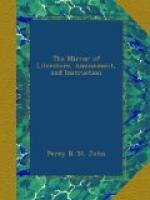* * * * *
SOUND.
The difficulty of transmitting sounds to a great distance arises from the sound spreading and losing itself in the surrounding air; so that if we could confine it on one side, as along a well—on two sides, as in a narrow street—or on all sides, as in a tube or pipe—we should be able to convey it to great distances. In the cast-iron water-pipe of Paris, which formed a continuous tube with only two bendings near its middle, the lowest whisper at one end was distinctly heard at the other, through a distance of 3,120 feet. A pistol fired at one end actually blew out a candle at the other end, and drove out light substances with great violence. Hence we see the operation of speaking tubes which pass from one part of a building to another, and of the new kind of bell which is formed of a wooden or tin tube, with a small piston at each end. By pushing in one piston, the air in the tube conveys the effect to the piston at the other end, which strikes against the bell—this piston being, as it were, the clapper on the outside of the bell. The intensity of confined sounds is finely exhibited at Carisbrook Castle, in the Isle of Wight. There is here a well 210 feet deep, of twelve feet in diameter, and lined with smooth masonry; and when a pin is dropped into it, the sound of its striking the surface of the water is distinctly heard.—Ibid.
* * * * *
ECHOES.
Various remarkable echoes, and some not very credible, have been described by different authors. Dr. Plott mentions an echo in Woodstock Park, which repeats seventeen syllables by day and twenty by night. The famous echo at the Marquess Simonetta’s villa, near Milan, has been described both by Addison and Keysler. According to the last of these travellers, it is occasioned by the reflection of the voice between the opposite parallel wings of the building, which are fifty-eight paces from each other, without any windows or doors, and perpendicularly to the main body of the building. The repetition of the sound dwells chiefly on the last syllable. A man’s voice is repeated about forty times, and the report of a pistol about sixty times; but the repetitions are so rapid, that it is difficult to number them, unless it be early in the morning, or in a calm, still evening.
A curious example of an oblique echo, not heard by the person who emits the sound, is described in the “Memoirs of the Academy of Sciences” as existing at Genefay, near Rouen. A person singing hears only his own direct voice, while those who listen hear only the echo, which sometimes seems to approach, and at other times to recede from, the ear; one person hears a single voice, another several voices; one hears the echo on the right, and another on the left—the effect constantly changing with the position of the observer.




